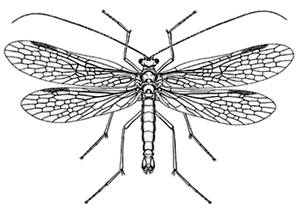|
Mecoptera:
scorpion flies
Characteristics
Scorpion
flies are small to medium sized insects with a wing span up to 50
millimetres in some species. Their name is derived from the fact
that the abdomens of some male species have genitalia that resemble
the stinging tail of a scorpion and will often fly with it raised.
Scorpion flies are often mistaken for giant mosquitoes or crane
flies (Diptera)
but can be distinguished by the following features:

Chorista species (CHORISTIDAE)
|
|
- 2 pairs of
membranous
wings of almost equal size. Some species are wingless
- Mandibulate
mouthparts at the end of a beak-like projection on the head
- Very long
spindly legs with strong claws
The larvae
of scorpion flies appear similar to caterpillars with short legs,
but do not possess prolegs
and have well developed mandibles.
Chorista
species (above) prefer to live close to water and are apparently
mainly herbivorous.
Adults lay their eggs in pockets in damp situations. The larvae
are almost completely smooth and live in the leaf litter and low
vegetation. They pupate
in earthen cells in the soil.
Life Cycle
The life
cycle of Scorpion flies is varied but in most cases the male attracts
the female with pheromones and offers her an insect meal he has
previously captured. It is thought this food is required by the
female to assist with egg development. Eggs are usually deposited
in the soil or moist leaf litter, while some species are aquatic
and eggs are placed in the water. Larvae develop through 3 instars
lasting approximately one month each before pupating
for up to several months within a chamber in the soil. Adults may
hatch in spring or autumn depending on the species.
Feeding
Scorpion
flies primarily feed on nectar, pollen, fruit and mosses although
males will also feed on many soft-bodied insects. Some species fly
among flowering plants preying on flies, bees, caterpillars and
other insect larvae. The diet of scorpion fly larvae is varied and
may include dead and dying insects or various plant materials.
Habitat
Scorpion
flies prefer cool, moist environments and are common around mountain
and coastal regions of the country, although some species are found
in the more marshy areas of inland Australia. Adults can often be
seen hanging from low vegetation waiting for a chance to capture
passing prey with their hind legs.
|

